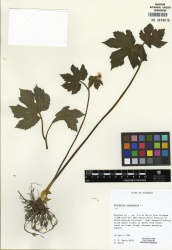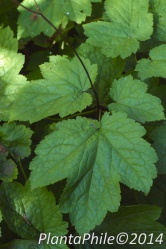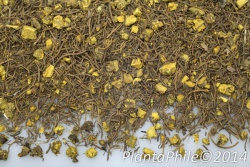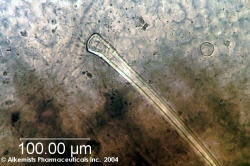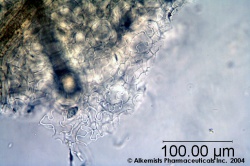Hydrastis canadensis (aerial parts)
From AHPA Botanical Identity References Compendium
(Difference between revisions)
(add macro characteristics) |
|||
| (2 intermediate revisions by one user not shown) | |||
| Line 1: | Line 1: | ||
| − | {{DISPLAYTITLE:''Hydrastis canadensis'' (aerial parts) }} | + | {{DISPLAYTITLE:''Hydrastis canadensis'' (aerial parts) }} {{askbox|herb=''Hydrastis canadensis''}} |
=Nomenclature= | =Nomenclature= | ||
| Line 28: | Line 28: | ||
=Macroscopic Characteristics= | =Macroscopic Characteristics= | ||
| + | {| border=1 | ||
| + | | | ||
| + | {{Macroscopy | source=American Medicinal Plants of Commercial Importance (1930) | ||
| + | | description=Goldenseal has a thick, yellow rootstock which sends up an erect, hairy stem about 1 foot in height which branches near the top, one branch bearing a large leaf and another a smaller leaf and a flower. The leaves have from five to nine lobes and when full grown are from 6 to 8 inches in diameter. The greenish white flower which appears in April or May is unattractive and peculiar in form and is followed by a large, fleshy, berrylike head, which when it ripens in autumn is bright red, resembling a large raspberry, and which contains from 10 to 20 small, shining, hard, black seeds. The rootstock when fresh is bright yellow externally and internally with fibrous rootlets produced from the sides. The latter when dry are very brittle and are frequently broken off when the rootstocks are handled. | ||
| + | }} | ||
| + | {{Macroscopy | source=United States Dispensatory (1918) | ||
| + | | description=Hydrastis canadensis is a small, herbaceous, perennial plant, with a thick, fleshy, yellow (rhizome, from which numerous long roots arise, and an erect, simple, pubescent stem, from six inches to a foot in height. There are usually but two leaves, which are unequal, one sessile at the top of the stem, the other attached to the stem, a short distance below by a thick roundish footstalk, causing the stem to appear as if bifurcate near the summit. The leaves are pubescent, roundish-cordate, with from three to seven, but generally five, lobes, which are pointed and unequally serrate. A solitary flower stands upon a peduncle rising from the basis of the upper leaf. It is without corolla, but with a greenish white calyx, the sepals of which closely resemble petals, and are very caducous, falling very soon after the flower has expanded. The fruit is a globose, compound, red or crimson berry, half an inch or more in diameter, composed of many fleshy carpels, each tipped with a short curved beak, and containing one or rarely two seeds. }} | ||
| + | |||
{{Media2 |cat=Macroscopy | {{Media2 |cat=Macroscopy | ||
| source=PlantaPhile | | source=PlantaPhile | ||
| Line 39: | Line 47: | ||
| companyURL2=http://plantaphile.com/ | | companyURL2=http://plantaphile.com/ | ||
| }} | | }} | ||
| + | |} | ||
=Microscopic Characteristics= | =Microscopic Characteristics= | ||
{{Media2 |cat=Microscopy | source=Elan M. Sudberg, Alkemist Laboratories | {{Media2 |cat=Microscopy | source=Elan M. Sudberg, Alkemist Laboratories | ||
Latest revision as of 18:36, 16 June 2015
Contents |
Nomenclature
Hydrastis canadensis L. Ranunculaceae
Standardized common name (English): goldenseal
Botanical Voucher Specimen
|
|
Organoleptic Characteristics
Macroscopic Characteristics
|
Microscopic Characteristics
 |
 |
|
|
|
High Performance Thin Layer Chromatographic Identification
Supplementary Information
Sources
- ↑ MOBOT, Tropicos.org http://www.tropicos.org/Image/100105541
- ↑ American Medicinal Plants of Commercial Importance (1930)
- ↑ United States Dispensatory (1918)
- ↑ PlantaPhile http://plantaphile.com/
- ↑ PlantaPhile http://plantaphile.com/
- ↑ Elan M. Sudberg, Alkemist Laboratories http://www.alkemist.com
- ↑ Elan M. Sudberg, Alkemist Laboratories http://www.alkemist.com
